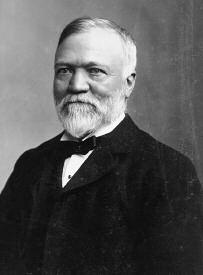Andrew Carnegie (1835–1919) industrialist
Born in Dunfermline, Scotland, in 1835, Carnegie immigrated to the United States with his family in 1848. The family settled in Pittsburgh, Pennsylvania, where Andrew went to work to help support the family rather than attend school. He took his first job in a factory when he was 13 for a salary of $1.20 per week.
After working at a telegraph company and teaching himself Morse code, Carnegie went to work for the Pennsylvania Railroad, where he was the personal assistant to Thomas Scott, later to be the railroad’s president. He worked at the railroad for 12 years before striking out on his own. Recognizing that the cargo the railroad carried, especially crude oil, was more lucrative than railroading itself, Carnegie made some investments that increased his annual income to almost $50,000 per year during the Civil War. In 1862, he organized a company to build iron bridges, initially for the Pennsylvania Railroad. The company was later reorganized as the Keystone Bridge Company and became one of the first companies to build bridges made of iron rather than wood, which had been the standard. The company supplied iron for the Eads Bridge over the Mississippi River in St. Louis and the Brooklyn Bridge over the East River in New York. In 1867, he organized the Keystone Telegraph Co. to lay telegraph wires alongside railroad lines, recognizing that the railroad phenomenon had created a communication as well as transportation revolution.
In the early 1870s, Carnegie decided to expand into steel production. Steel had been improved significantly by the Bessemer process, developed in Britain by Henry Bessemer, and Carnegie decided to begin manufacturing it in the United States. Within a short period of time, he was producing steel for the RAILROADS and was quickly becoming one of the largest producers in the country. His first steel company was called Carnegie, McCandless & Co. His management style included a rigorous use of cost-cutting measures designed to make production as efficient as possible while keeping costs down. In 1889, he published the “Gospel of Wealth,” in which he held that the wealthy have an obligation to guard society because of their wealth and merit. He later changed his views on social matters to more egalitarian positions. Although highly successful, a future acquisition caused Carnegie eventually to reconsider his involvement in the industry.

In 1883, he acquired the Homestead steelworks in Pennsylvania but also inherited a labor dispute between the management of the company and its union, the Amalgamated Association of Iron and Steel Workers. Henry Clay FRICK was manager of the Homestead plant after Carnegie acquired it and adopted a hard-line position concerning striking workers. Frick attempted to break the union’s hold on the plant and hired private Pinkerton detectives to guard against the workers. In the summer of 1892, a pitched battle broke out between the workers and guards. A total of 18 died in the battle before order was restored. The plant only reopened a year later in 1893. The public commotion caused by the affair brought labor practices in general, and Carnegie’s management of the plant specifically, under close scrutiny. The conflict tore at his interest in promoting labor’s objectives on the one hand and cost efficiency on the other.
Finally, Carnegie decided to sell what had become Carnegie Steel to J. P. Morgan in 1901. He was approached by Charles SCHWAB, a close ally of Morgan, about selling the steelworks and wrote the selling price on a piece of paper that Schwab immediately gave to Morgan. Morgan agreed to the $480 million purchase price, to be paid in bonds and stock, and the deal became the largest takeover in history. The resulting company became known as U.S. STEEL and was the largest in the world. It was the first company whose balance sheet was valued at more than $1 billion. As a result, Carnegie became the richest man in the world. He also became one of the most disconsolate, at least temporarily, when Morgan later confided to him that he could have received $100 million more if he had held out for a higher price.
After selling Carnegie Steel, Carnegie engaged in philanthropy on a scale not yet seen in American business. He founded the Carnegie Institute of Technology in 1900 and endowed thousands of public libraries, colleges, and universities through the Carnegie Endowment, established in 1911. He also established the Carnegie Endowment for International Peace in 1910. He died in Massachusetts in 1919.
See also MORGAN, JOHN PIERPONT; STEEL INDUSTRY.
Further reading
- Carnegie, Andrew. Autobiography of Andrew Carnegie. Boston: Houghton Mifflin, 1920.
- Krass, Peter. Carnegie. New York: John Wiley & Sons, 2002.
- Livesay, Harold C., and Oscar Handlin. Andrew Carnegie and the Rise of Big Business. 2nd ed. New York: Longman, 2000.
- Shippen, Katherine. Andrew Carnegie and the Age of Steel. New York: Random House, 1964.
- Tedlow, Richard S. Giants of Enterprise: Seven Business Innovators and the Empires They Built. New York: HarperBusiness, 2001.
- Wall, Joseph Frazier. Andrew Carnegie. 2nd ed. Pittsburgh: University of Pittsburgh Press, 1989.